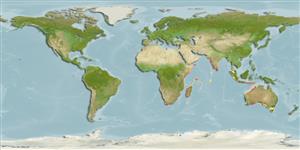>
Carangiformes (Jacks) >
Carangidae (Jacks and pompanos) > Trachinotinae
Etymology: Trachinotus: Greek, trachys, -eia, -ys = rough + Greek,noton = back (Ref. 45335).
More on author: Smith.
Environment: milieu / climate zone / depth range / distribution range
Ökologie
seewasser; brackwasser riff-verbunden; tiefenbereich 20 - 50 m (Ref. 28016). Tropical
Indian Ocean: Gulf of Aden and Oman, Mozambique and South Africa to western Indonesia.
Size / Gewicht / Alter
Maturity: Lm ? range ? - ? cm
Max length : 92.0 cm TL Männchen/unbestimmt; (Ref. 3287); max. veröff. Gewicht: 14.1 kg (Ref. 3287)
Rückenflossenstacheln (insgesamt) : 7; Rückenflossenweichstrahlen (insgesamt) : 21 - 23; Afterflossenstacheln: 3; Afterflossenweichstrahlen: 19 - 21.
Adults inhabit coastal areas with reefs or rocky outcrops (Ref. 3197). They are found normally in pairs on reefs but may be solitary or form schools (Ref. 5213, 90102). Juveniles in sheltered bays. Adults feed on mollusks (mussels) and crabs (Ref. 5213).
Life cycle and mating behavior
Geschlechtsreife | Fortpflanzung | Ablaichen | Eier | Fecundity | Larven
Smith-Vaniz, W.F., 1984. Carangidae. In W. Fischer and G. Bianchi (eds.) FAO species identification sheets for fishery purposes. Western Indian Ocean fishing area 51. Vol. 1. [pag. var.]. FAO, Rome. (Ref. 3287)
IUCN Rote Liste Status (Ref. 130435: Version 2024-1)
Bedrohung für Menschen
Harmless
Nutzung durch Menschen
Fischereien: weniger kommerziell; Sportfisch: ja; Aquarium: Öffentliche Aquarien
Tools
Zusatzinformationen
Download XML
Internet Quellen
Estimates based on models
Preferred temperature (Ref.
123201): 18.3 - 28.2, mean 26.2 °C (based on 49 cells).
Phylogenetic diversity index (Ref.
82804): PD
50 = 0.5000 [Uniqueness, from 0.5 = low to 2.0 = high].
Bayesian length-weight: a=0.01995 (0.00854 - 0.04661), b=2.87 (2.69 - 3.05), in cm total length, based on LWR estimates for this Genus-body shape (Ref.
93245).
Trophic level (Ref.
69278): 3.4 ±0.35 se; based on food items.
Widerstandsfähigkeit (Ref.
120179): mittel, Verdopplung der Population dauert 1,4 - 4,4 Jahre. (Preliminary K or Fecundity.).
Fishing Vulnerability (Ref.
59153): High vulnerability (57 of 100).
Nutrients (Ref.
124155): Calcium = 36.3 [16.0, 66.7] mg/100g; Iron = 0.608 [0.341, 1.244] mg/100g; Protein = 19.4 [17.4, 21.4] %; Omega3 = 0.103 [0.063, 0.184] g/100g; Selenium = 40.6 [21.7, 82.3] μg/100g; VitaminA = 25.4 [6.5, 92.8] μg/100g; Zinc = 0.965 [0.641, 1.400] mg/100g (wet weight);
